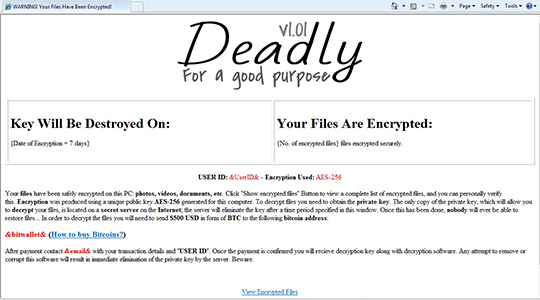RANSOM_EDA2JANBLEED.A
Windows


Threat Type: Trojan
Destructiveness: No
Encrypted:
In the wild: Yes
OVERVIEW
Dropped by other malware, Downloaded from the Internet
This Trojan arrives on a system as a file dropped by other malware or as a file downloaded unknowingly by users when visiting malicious sites.
TECHNICAL DETAILS
59,392 bytes
EXE
Yes
26 Sep 2016
Encrypts files, Displays graphics/image
Arrival Details
This Trojan arrives on a system as a file dropped by other malware or as a file downloaded unknowingly by users when visiting malicious sites.
Installation
This Trojan drops the following files:
- %Desktop%\logo.png
- %Desktop%\filesencrypted.html - list of encrypted files
- %Application Data%\SysData\files.txt - list of files to encrypt
- %Desktop%\ransome.html - ransom note
- %AppDataLocal%\JB\core32x86.exe_Url_q2kl0kaaan4v5u5tvd5noc2mivsopa0z\2.9.3.0\user.config
(Note: %Desktop% is the desktop folder, where it usually is C:\Documents and Settings\{user name}\Desktop in Windows 2000, Windows Server 2003, and Windows XP (32- and 64-bit); C:\Users\{user name}\Desktop in Windows Vista (32- and 64-bit), Windows 7 (32- and 64-bit), Windows 8 (32- and 64-bit), Windows 8.1 (32- and 64-bit), Windows Server 2008, and Windows Server 2012.. %Application Data% is the Application Data folder, where it usually is C:\Documents and Settings\{user name}\Application Data on Windows 2000, Windows Server 2003, and Windows XP (32- and 64-bit); C:\Users\{user name}\AppData\Roaming on Windows Vista (32- and 64-bit), Windows 7 (32- and 64-bit), Windows 8 (32- and 64-bit), Windows 8.1 (32- and 64-bit), Windows Server 2008, and Windows Server 2012.. %AppDataLocal% is the Application Data folder found in Local Settings, where it is usually C:\Documents and Settings\{user name}\Local Settings\Application Data on Windows 2000, Windows Server 2003, and Windows XP (32- and 64-bit); C:\Users\{user name}\AppData\Local on Windows Vista (32- and 64-bit), Windows 7 (32- and 64-bit), Windows 8 (32- and 64-bit), Windows 8.1 (32- and 64-bit), Windows Server 2008, and Windows Server 2012.)
It creates the following folders:
- %Application Data%\sysData
- %AppDataLocal%\JB
- %AppDataLocal%\JB\core32x86.exe_Url_q2kl0kaaan4v5u5tvd5noc2mivsopa0z
- %AppDataLocal%\JB\core32x86.exe_Url_q2kl0kaaan4v5u5tvd5noc2mivsopa0z\2.9.3.0
(Note: %Application Data% is the Application Data folder, where it usually is C:\Documents and Settings\{user name}\Application Data on Windows 2000, Windows Server 2003, and Windows XP (32- and 64-bit); C:\Users\{user name}\AppData\Roaming on Windows Vista (32- and 64-bit), Windows 7 (32- and 64-bit), Windows 8 (32- and 64-bit), Windows 8.1 (32- and 64-bit), Windows Server 2008, and Windows Server 2012.. %AppDataLocal% is the Application Data folder found in Local Settings, where it is usually C:\Documents and Settings\{user name}\Local Settings\Application Data on Windows 2000, Windows Server 2003, and Windows XP (32- and 64-bit); C:\Users\{user name}\AppData\Local on Windows Vista (32- and 64-bit), Windows 7 (32- and 64-bit), Windows 8 (32- and 64-bit), Windows 8.1 (32- and 64-bit), Windows Server 2008, and Windows Server 2012.)
Autostart Technique
This Trojan drops the following file(s) in the Windows Startup folder to enable its automatic execution at every system startup:
- core32x86.exe
Propagation
This Trojan drops the following copy(ies) of itself in all removable drives:
- setup.exe
Process Termination
This Trojan terminates processes or services that contain any of the following strings if found running in the affected system's memory:
- taskmgr
Other Details
This Trojan encrypts files with the following extensions:
- .txt
- .jpg
- .png
- .doc
- .docx
- .csv
- .sql
- .mdb
- .sln
- .php
- .asp
- .aspx
- .html
- .htm
- .csx
- .psd
It opens the following files:
- %Desktop%\ransome.html
(Note: %Desktop% is the desktop folder, where it usually is C:\Documents and Settings\{user name}\Desktop in Windows 2000, Windows Server 2003, and Windows XP (32- and 64-bit); C:\Users\{user name}\Desktop in Windows Vista (32- and 64-bit), Windows 7 (32- and 64-bit), Windows 8 (32- and 64-bit), Windows 8.1 (32- and 64-bit), Windows Server 2008, and Windows Server 2012.)
It renames encrypted files using the following names:
- {original filename}.a858
It does the following:
- Drops copies of itself in archived files with the following extensions:
- .rar
- .zip
NOTES:
This ransomware only executes when system year is 2017.
It also opens the following webpage after encryption:

SOLUTION
9.800
12.812.03
02 Oct 2016
12.813.00
03 Oct 2016
Step 1
Before doing any scans, Windows XP, Windows Vista, and Windows 7 users must disable System Restore to allow full scanning of their computers.
Step 2
Note that not all files, folders, and registry keys and entries are installed on your computer during this malware's/spyware's/grayware's execution. This may be due to incomplete installation or other operating system conditions. If you do not find the same files/folders/registry information, please proceed to the next step.
Step 3
Restart in Safe Mode
Step 4
Search and delete this file
- %Desktop%\ransome.html
- %Application Data%\SysData\files.txt
- %AppDataLocal%\JB\core32x86.exe_Url_q2kl0kaaan4v5u5tvd5noc2mivsopa0z\2.9.3.0\user.config
- %Desktop%\filesencrypted.html
- %Desktop%\logo.png
Step 5
Search and delete these folders
- %Application Data%\sysData
- %AppDataLocal%\JB
Step 6
Restart in normal mode and scan your computer with your Trend Micro product for files detected as RANSOM_EDA2JANBLEED.A. If the detected files have already been cleaned, deleted, or quarantined by your Trend Micro product, no further step is required. You may opt to simply delete the quarantined files. Please check this Knowledge Base page for more information.
Step 7
Restore encrypted files from backup.
Did this description help? Tell us how we did.

